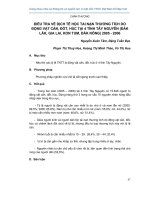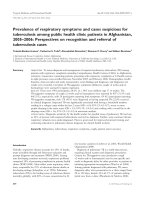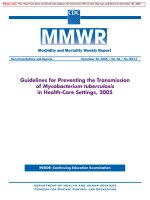2005 week3 imageformation
Bạn đang xem bản rút gọn của tài liệu. Xem và tải ngay bản đầy đủ của tài liệu tại đây (573.86 KB, 58 trang )
Principles of MRI:
Image Formation
Allen W. Song
Brain Imaging and Analysis Center
Duke University
What is image formation?
To define the spatial location of the sources
that contribute to the detected signal.
But MRI does not use projection, reflection, or refraction
mechanisms commonly used in optical imaging methods
to form image. So how are the MR images formed?
Frequency and Phase Are Our Friends in MR Imaging
ω
θ = ωt
θ
The spatial information of the proton pools contributing
MR signal is determined by the spatial frequency and
phase of their magnetization.
Gradient Coils
z
z
z
y
y
x
x
X gradient
y
Y gradient
x
Z gradient
Gradient coils generate spatially varying magnetic field
so that spins at different location precess at frequencies
unique to their location, allowing us to reconstruct 2D
or 3D images.
0.8
A Simple Example of Spatial Encoding
Constant
Magnetic
Field
w/o encoding
Varying
Magnetic
Field
w/ encoding
Spatial Decoding of the MR Signal
Frequency
Decomposition
Steps in 3D Localization
♦Can only detect total RF signal from inside the “RF
coil” (the detecting antenna)
Excite and receive Mxy in a thin (2D) slice of the
subject
The RF signal we detect must come from this slice
Reduce dimension from 3D down to 2D
Deliberately make magnetic field strength B depend
on location within slice
Frequency of RF signal will depend on where it comes from
Breaking total signal into frequency components will provide
more localization information
Make RF signal phase depend on location within slice
Exciting and Receiving Mxy in a Thin Slice of Tissue
Excite:
Source of RF frequency on resonance
Addition of small frequency variation
Amplitude modulation with “sinc” function
RF power amplifier
RF coil
Electromagnetic Excitation Pulse (RF Pulse)
Fo
0
t
FT
Time
Fo Fo+1/ t
Frequency
Fo
t
FT
Fo
∆F= 1/ t
Gradient Fields: Spatially Nonuniform B:
♦During readout (image acquisition) period, turning on gradient field is
called frequency encoding --- using a deliberately applied nonuniform
field to make the precession frequency depend on location
♦ Before readout (image acquisition) period, turning on gradient field is
called phase encoding --- during the readout (image acquisition) period,
the effect of gradient field is no longer time-varying, rather it is a fixed
phase accumulation determined by the amplitude and duration of the
phase encoding gradient.
60 KHz
Center
frequency
[63 MHz at 1.5 T]
Left = –7 cm
f
Gx = 1 Gauss/cm = 10 mTesla/m
= strength of gradient field
x-axis
Right = +7 cm
Exciting and Receiving Mxy in a Thin Slice of Tissue
Receive:
RF coil
RF preamplifier
Filters
Analog-to-Digital Converter
Computer memory
Slice Selection
Slice Selection – along z
z
Determining slice thickness
Resonance frequency range as the result
of slice-selective gradient:
∆F = γ H * Gsl * dsl
The bandwidth of the RF excitation pulse:
∆ω/2π
Thus the slice thickness can be derived as
dsl = ∆ω / (γ H * Gsl * 2π)
Changing slice thickness
There are two ways to do this:
(a) Change the slope of the slice selection gradient
(b) Change the bandwidth of the RF excitation pulse
Both are used in practice, with (a) being more popular
Changing slice thickness
new slice
thickness
Selecting different slices
In theory, there are two ways to select different slices:
(a) Change the position of the zero point of the slice
selection gradient with respect to isocenter
(b) Change the center frequency of the RF to correspond
to a resonance frequency at the desired slice
F = γ H (Bo + Gsl * Lsl )
Option (b) is usually used as it is not easy to change the
isocenter of a given gradient coil.
Selecting different slices
new slice
location
Readout Localization (frequency encoding)
♦After RF pulse (B ) ends, acquisition (readout) of NMR
1
RF signal begins
• During readout, gradient field perpendicular to slice
selection gradient is turned on
• Signal is sampled about once every few microseconds,
digitized, and stored in a computer
• Readout window ranges from 5–100 milliseconds (can’t be longer
than about 2⋅ T2*, since signal dies away after that)
• Computer breaks measured signal V(t) into frequency
components v(f ) — using the Fourier transform
• Since frequency f varies across subject in a known way, we
can assign each component v(f ) to the place it comes from
Spatial Encoding of the MR Signal
Constant
Magnetic
Field
w/o encoding
Varying
Magnetic
Field
w/ encoding
It’d be easy if we image with only 2 voxels …
But often times we have imaging matrix at 256 or higher.
More Complex Spatial Encoding
x gradient
More Complex Spatial Encoding
y gradient
A 9×9 case
Physical Space
MR data space
After Frequency Encoding
(x gradient)
So each data point contains information from all the voxels
Before Encoding









